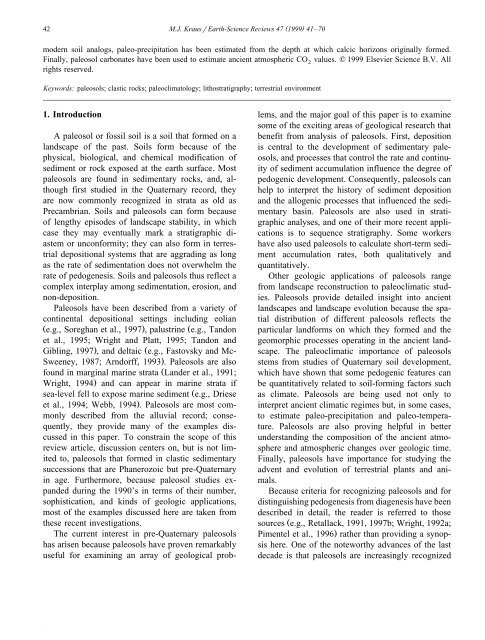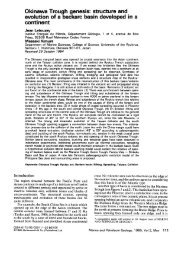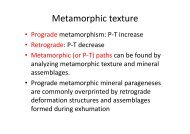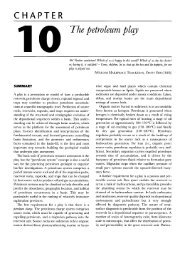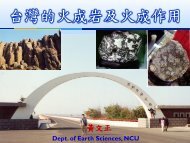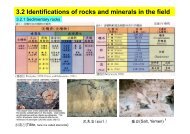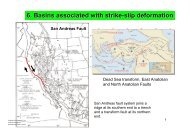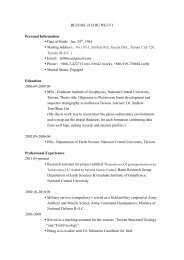Paleosols in clastic sedimentary rocks: their geologic applications
Paleosols in clastic sedimentary rocks: their geologic applications
Paleosols in clastic sedimentary rocks: their geologic applications
- No tags were found...
You also want an ePaper? Increase the reach of your titles
YUMPU automatically turns print PDFs into web optimized ePapers that Google loves.
42( )M.J. KrausrEarth-Science ReÕiews 47 1999 41–70modern soil analogs, paleo-precipitation has been estimated from the depth at which calcic horizons orig<strong>in</strong>ally formed.F<strong>in</strong>ally, paleosol carbonates have been used to estimate ancient atmospheric CO2values. q 1999 Elsevier Science B.V. Allrights reserved.Keywords: paleosols; <strong>clastic</strong> <strong>rocks</strong>; paleoclimatology; lithostratigraphy; terrestrial environment1. IntroductionA paleosol or fossil soil is a soil that formed on alandscape of the past. Soils form because of thephysical, biological, and chemical modification ofsediment or rock exposed at the earth surface. Mostpaleosols are found <strong>in</strong> <strong>sedimentary</strong> <strong>rocks</strong>, and, althoughfirst studied <strong>in</strong> the Quaternary record, theyare now commonly recognized <strong>in</strong> strata as old asPrecambrian. Soils and paleosols can form becauseof lengthy episodes of landscape stability, <strong>in</strong> whichcase they may eventually mark a stratigraphic diastemor unconformity; they can also form <strong>in</strong> terrestrialdepositional systems that are aggrad<strong>in</strong>g as longas the rate of sedimentation does not overwhelm therate of pedogenesis. Soils and paleosols thus reflect acomplex <strong>in</strong>terplay among sedimentation, erosion, andnon-deposition.<strong>Paleosols</strong> have been described from a variety ofcont<strong>in</strong>ental depositional sett<strong>in</strong>gs <strong>in</strong>clud<strong>in</strong>g eolianŽ e.g., Soreghan et al., 1997 ., palustr<strong>in</strong>e Že.g., Tandonet al., 1995; Wright and Platt, 1995; Tandon andGibl<strong>in</strong>g, 1997 ., and deltaic Že.g., Fastovsky and Mc-Sweeney, 1987; Arndorff, 1993 .. <strong>Paleosols</strong> are alsofound <strong>in</strong> marg<strong>in</strong>al mar<strong>in</strong>e strata ŽLander et al., 1991;Wright, 1994.and can appear <strong>in</strong> mar<strong>in</strong>e strata ifsea-level fell to expose mar<strong>in</strong>e sediment Že.g., Drieseet al., 1994; Webb, 1994 .. <strong>Paleosols</strong> are most commonlydescribed from the alluvial record; consequently,they provide many of the examples discussed<strong>in</strong> this paper. To constra<strong>in</strong> the scope of thisreview article, discussion centers on, but is not limitedto, paleosols that formed <strong>in</strong> <strong>clastic</strong> <strong>sedimentary</strong>successions that are Phanerozoic but pre-Quaternary<strong>in</strong> age. Furthermore, because paleosol studies expandeddur<strong>in</strong>g the 1990’s <strong>in</strong> terms of <strong>their</strong> number,sophistication, and k<strong>in</strong>ds of <strong>geologic</strong> <strong>applications</strong>,most of the examples discussed here are taken fromthese recent <strong>in</strong>vestigations.The current <strong>in</strong>terest <strong>in</strong> pre-Quaternary paleosolshas arisen because paleosols have proven remarkablyuseful for exam<strong>in</strong><strong>in</strong>g an array of <strong>geologic</strong>al problems,and the major goal of this paper is to exam<strong>in</strong>esome of the excit<strong>in</strong>g areas of <strong>geologic</strong>al research thatbenefit from analysis of paleosols. First, depositionis central to the development of <strong>sedimentary</strong> paleosols,and processes that control the rate and cont<strong>in</strong>uityof sediment accumulation <strong>in</strong>fluence the degree ofpedogenic development. Consequently, paleosols canhelp to <strong>in</strong>terpret the history of sediment depositionand the allogenic processes that <strong>in</strong>fluenced the <strong>sedimentary</strong>bas<strong>in</strong>. <strong>Paleosols</strong> are also used <strong>in</strong> stratigraphicanalyses, and one of <strong>their</strong> more recent <strong>applications</strong>is to sequence stratigraphy. Some workershave also used paleosols to calculate short-term sedimentaccumulation rates, both qualitatively andquantitatively.Other <strong>geologic</strong> <strong>applications</strong> of paleosols rangefrom landscape reconstruction to paleoclimatic studies.<strong>Paleosols</strong> provide detailed <strong>in</strong>sight <strong>in</strong>to ancientlandscapes and landscape evolution because the spatialdistribution of different paleosols reflects theparticular landforms on which they formed and thegeomorphic processes operat<strong>in</strong>g <strong>in</strong> the ancient landscape.The paleoclimatic importance of paleosolsstems from studies of Quaternary soil development,which have shown that some pedogenic features canbe quantitatively related to soil-form<strong>in</strong>g factors suchas climate. <strong>Paleosols</strong> are be<strong>in</strong>g used not only to<strong>in</strong>terpret ancient climatic regimes but, <strong>in</strong> some cases,to estimate paleo-precipitation and paleo-temperature.<strong>Paleosols</strong> are also prov<strong>in</strong>g helpful <strong>in</strong> betterunderstand<strong>in</strong>g the composition of the ancient atmosphereand atmospheric changes over <strong>geologic</strong> time.F<strong>in</strong>ally, paleosols have importance for study<strong>in</strong>g theadvent and evolution of terrestrial plants and animals.Because criteria for recogniz<strong>in</strong>g paleosols and fordist<strong>in</strong>guish<strong>in</strong>g pedogenesis from diagenesis have beendescribed <strong>in</strong> detail, the reader is referred to thosesources Že.g., Retallack, 1991, 1997b; Wright, 1992a;Pimentel et al., 1996.rather than provid<strong>in</strong>g a synopsishere. One of the noteworthy advances of the lastdecade is that paleosols are <strong>in</strong>creas<strong>in</strong>gly recognized


